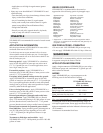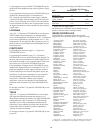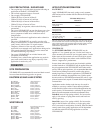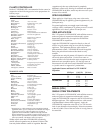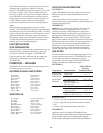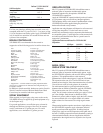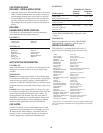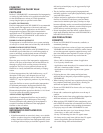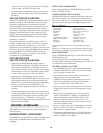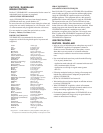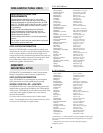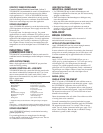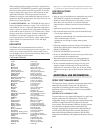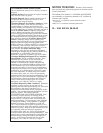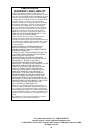
When treating brush that requires more than a single delivery
of the DuPont™ VELPAR® DF suspension, apply subsequent
deliveries equally spaced around the target plant. If treating
brush on sloping sites, apply most of the suspension on the
uphill side of the stem. If treating resprouts from brush
disturbed by cutting or other mechanical methods, the rate of
application should be proportional to the original tree size, not
just the size of sprout regrowth.
LACING/STREAKING - Mix VELPAR® DF with water to
form a concentrated suspension. Apply 5 1/3 to 10 2/3 lbs of
VELPAR® DF per acre. Adjust the application equipment to
deliver a narrow or straight stream spray pattern such that the
swath width on the soil surface is 6 to 12 inches wide. Direct
the spray at the base of the brush. Swaths or treated bands
should be 2 to 4 feet apart. Apply the lower volumes for
coarse textured soils or soils with low organic matter and the
higher volumes for fine textured soils or soils with high
organic matter.
USE RATES
VELPAR® DF is recommended for the control or
suppression of the following species in non-crop sites. Use
lower rate on coarse-textured soils (sand to sandy loam).
Use the higher rate on fine-textured soils(clay loam to clay)
and on soils high in organic matter.
5 1/3 to 10 2/3 Lb/Acre
*Suppression – a visible reduction in plant population and/or plant vigor
as compared to an untreated area and generally not accepted as control.
USE PRECAUTIONS
NON-CROP
• Injury to or loss of desirable trees or other plants may result if
VELPAR® DF is applied or if equipment is drained or
flushed on or near desirable trees or other plants, on areas
where their roots may extend, or in locations where the
chemical may be washed or moved into contact with their
roots.
• Application spray drift may injure desirable plants.
• Poor weed and brush control may result from the following:
–Use on poorly drained sites
–Applications made when the soil is saturated with water and
rain is imminent within 24 hours.
–Applications to soils high in organic matter (greater
than 5%).
• Following mechanical cutting or clearing, allow stumps and
injured trees sufficient time to adequately resprout before
applying VELPAR® DF.
• Do not use VELPAR® DF on frozen soils.
• Do not use VELPAR® DF on lawns, driveways, tennis courts,
or other residential or recreational areas.
•Weed and brush control results from spring applications
depend on sufficient moisture to activate VELPAR® DF.
• Do not cut treated vegetation for forage or hay nor graze
domestic animals on treated areas for 60 days following
application. For rates above 8 lb per acre, do not cut treated
vegetation for forage or hay nor graze domestic animals for 1
year.
SPRAY DRIFT MANAGEMENT
The interaction of many equipment- and weather-related factors
determines the potential for spray drift. The applicator is
responsible for considering all these factors when making
application decisions. Avoiding spray drift is the responsibility
of the applicator.
IMPORTANCE OFDROPLET SIZE
The most effective way to reduce drift potential is to apply large
droplets (greater than 150–200 microns). The best drift
management strategy is to apply the largest droplets that provide
sufficient coverage and control. The presence of sensitive
species nearby, the environmental conditions, and pest pressure
may affect how an applicator balances drift control and
coverage. Applying larger droplets reduces drift potential, but
will not prevent drift if applications are made improperly or
under unfavorable environmental conditions! See the Wind,
Temperature and Humidity, and Temperature Inversions sections
below.
ADDITIONAL USE INFORMATION
Alder Alnus spp
Ash Fraxinus spp
Aspen Populus spp
Birch Betula spp
Blackgum Nyssa sylvatica
Bay, sweet Magnolia virginiana
Catclaw acacia Acacia greggii
Cedar, Eastern red Juniperus virginiana
Cherry, black Prunus serotina
Chinaberry* Melia azedarach
Deerbrush Ceanothus integerrimus
Dogwood, flowering* Cornus florida
Elm, American Ulmus Americana
Elm, Chinese Ulmus parvifolia
Hackberry, common Celtis occidentalis
Hawthorn Crataegus spp
Hazel Corylus spp
Hickory Carya spp
Huisache Acacia farnesiana
Juniper Juniperus spp
Locust Robinia spp
Lotebush Ziziphus obtusifolia
Manzanita, Greenleaf Arctostaphylos patula
Maple, red Acer rubrum
Mesquite Prosopis glandulosa
Mulberry Morus spp
Oaks Quercus spp
Osage-orange Maclura pomifera
Persimmon Diospyros spp
Plum, wild Prunus munsoniana
Poplar, balsam Populus balsamifera
Poplar, yellow Liriodendron tulipifera
Privet Ligustrum spp
Rose, multiflora Rosa multiflora
Sassafras* Sassafras albidum
Soapweed, small (yucca) Yucca glauca
Snowbrush (varnishleaf) Ceanothus velutinus
Sourwood Oxydendrum arboretum
Sumac Rhus spp
Sweetgum Liquidambar spp
Tallow, Chinese Sapium sebiferum
Waxmyrtle Myrica cerifera
Whitebrush Aloysia gratissima
Willow Salix spp
22



